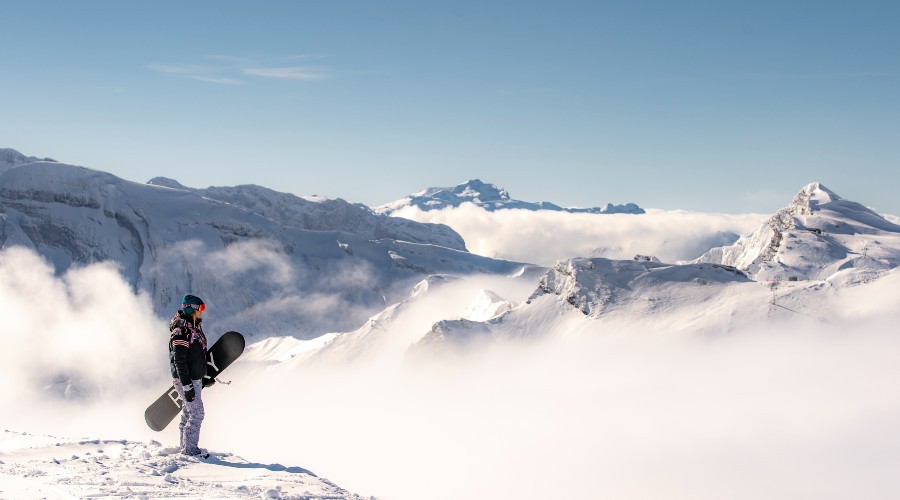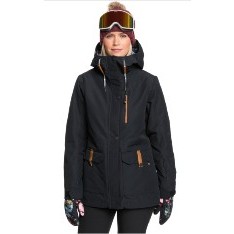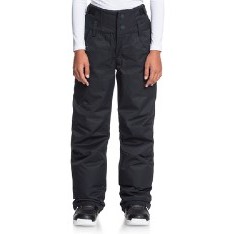How To Dress for Snowboarding: The Essentials

Knowing what to wear when you go snowboarding is vital to making the most out of your time on the mountain. We’ve put together a guide of everything you need to know before you go.
Snowboarding Packing List: The Basics
Besides your snowboard and bindings, a few essential items will make any day on the mountain a good one.
- Boots. Warm and waterproof boots made especially for snowboarding. Snowboard boots have a soft inner liner and a hard outer boot designed to keep snow out and help you control your snowboard.
- Outerwear. A set of pants and a jacket that are waterproof and warm all the while keeping the elements out.
- Layers. A base layer and a mid-layer are usually worn underneath outerwear to help retain body heat and insulate your core.
- Gloves. Snowboard-specific gloves will provide warmth, keep your hands dry, and allow you to do up your snowboard bindings.
- Goggles. Snow goggles protect your eyes from wind, snow and sun while giving you broad peripheral vision.
- Helmet & Wrist Guards. A snow-specific helmet will protect your head if you stack it and keep your ears warm. Wrist guards are another essential piece of equipment for beginner snowboarders as they protect your wrist and hands while learning.
What To Wear Snowboarding: First Time or Advanced
If it's your first time snowboarding, renting a snowboard, boots, and bindings can be a great way to get started in the sport without spending an arm and a leg. For your first few trips, head to a rental store and rent any essential gear like a snowboard, boots, bindings and a helmet. Alternatively, you can borrow snowboarding equipment from friends or family before you're ready to invest in your own gear. Other than snowboard boots, protective gear like wrist guards, knee and elbow pads are essential for any beginner snowboard. As well as reducing injuries, staying well protected during the early days helps boost your confidence, and you’ll progress much faster.
Once your skills and enjoyment of snowboarding have improved, you’ll probably want to start investing in big-ticket items like a snowboard, boots, bindings and outerwear. Make sure you read our expert guide on choosing the right snowboard jacket and pants.
Snowboarding Basics: Layers
Finding the right balance of layers to stay warm and comfortable while snowboarding can be a bit of trial and error. Snowboarding is an intense sport where you alternate between riding and resting (on the chairlift) multiple times a day and often in changing weather conditions. Maintaining a comfortable body temperature comes down to a good layering system, which usually comes down to personal preference and experience.
To stay comfortable in different weather conditions, it’s vital to keep your skin dry using a technical, moisture-wicking base layer and stay warm (but not too hot) by adding or subtracting mid-layers according to the outside temperature. Here are some basic pointers for getting your layering right.
- Your snowboard base layer should be a stretchy, snug-fitting top and bottom designed to give you maximum freedom without making you feel bulky. Look for technical synthetic fabrics like polyester or merino wool, which are warm, fast drying and wick away sweat. Base layers are often called thermals or skivvies.
- One or more snowboard mid-layer can be worn between your base layer and outerwear to provide extra insulation and can be removed if you get too hot. Mid-layers can be a hoody, a fleece, or a puffer jacket. Just like your base layer, synthetic fabrics or wool are the main types of fabric to look for when choosing a mid-layer as they retain heat without getting too smelly, whereas cotton absorbs moisture and will stay wet underneath your outerwear.

Snowboarding Basics: Snowboard Jackets
There are two basic types of snowboard jackets – insulated and un-insulated (shell). Both types come in a wide range of fits and have a wide range of features to suit all types of snowboarders in any weather condition.
- Insulated Jacket or Shell? Insulated jackets are often the more popular choice as they offer instant warmth and comfort in cold, wintery environments. Different insulation levels will suit varying winter conditions depending on where you are snowboarding. Lightweight and low bulk insulated jackets are more common for everyday snowboarding, whereas thick, feather-down jackets can be better in colder climate snow resorts. Shell jackets or un-insulated jackets tend to be more popular for spring riding or exploring the backcountry. Some riders are looking for a lightweight, high-performance jacket with superior waterproofness and breathability.
- Waterproofness and breathability: When choosing a snowboard jacket, it is important to consider how waterproof and breathable your jacket will be. Each jacket will have a different level of waterproofing and breathability, allowing heat and moisture to escape from the inside of the jacket through a membrane while also stopping water and snow from getting in. Look on the jacket sizing tag or swing tag for its waterproof and breathability rating. These ratings typically start around 5k/5k waterproofness/breathability, generally seen as providing entry-level performance, while premium products like Gore-Tex are around the 20k/20k mark.
- Essential features: Every snow jacket will have similar base features designed to keep you warm, dry and comfortable all day. Under arm venting is critical when you need to cool down quickly. A powder skirt is an elasticated flap of waterproof fabric that sits around the waist to keep snow from coming up inside the jacket when adjusting your bindings or if you fall over.

Snowboarding Basics: Snowboard Pants
There are basically four types of snowboard pants – insulated, un-insulated, shell and bib/overalls. Because the insulation is less important for the legs than the torso and most riders wear a thermal base layer underneath, insulated pants usually contain lightweight, low-profile synthetic insulation to add extra warmth without adding bulk. un-insulated pants offer a liner for extra comfort, and shell pants are made with technical 3L fabrics that do not require a liner and offer the most breathability. Bib or overall style pants are a fashionable and functional option that extends coverage up past the waistline, making them ideal both with a jacket in winter conditions and without in warmer spring conditions.
As with snowboarding jackets, the two essentials to look out for when choosing snowboard pants are mesh-backed venting around the inner thigh/knees area to quickly dump excess heat and moisture, and elasticated ankle gaiters that stretch over the boot and prevent snow from getting in.
Snowboarding Basics: Helmets
-
Helmets are now an everyday accessory for snowboarders and skiers thanks to constant safety improvements, added comfort and style. Today, 80% of snowboarders and skiers wear a helmet on the snow, whether they are beginners or pros. It's a requirement for all kids in ski and snowboard lessons to wear a helmet! Here is a brief checklist on how to find the correct fitting helmet.
- A helmet should feel firm and comfortable with no weird pressure points or pain with the chin strap clipped up to secure the helmet under your chin.
- Bring your goggles along when fitting a helmet to ensure that the goggles and helmet fit together on your face.
- Many helmets come with a size adjuster and different types of ventilation so consider which features you would like to have in your helmet.
- Ensure that your helmet conforms to a recognised safety standard, such as the EN 1077. Bike, skateboarding or non-snow-specific helmets should not be worn when snowboarding or skiing.
Snowboard Basics: Boots
Possibly the most important piece of snowboarding equipment, a well-fitted pair of snowboard boots is absolutely essential to having an excellent snowboarding experience. Book in to have a boot fitting done with a qualified snowboard boot fitter. A boot fitter can help you find the right fit and flex while ensuring that your new boots will be compatible with your bindings. Snowboard boots must be waterproof and durable enough to survive months of wear and tear from snow, ice, rocks and binding straps. For this reason, it’s important to do your research and, if you can, try before you buy. Here are the key features to take into consideration when shopping for your dream pair of snowboard boots.
-
- Flex: Snowboard boot flex is related to the responsiveness of a snowboard boot and differs from brand to brand. Most beginner and freestyle riders opt for a softer flex boot, whereas more advanced, all-mountain snowboarders prefer a stiffer boot. Boot flex can also depend on how flexible your ankle is and your riding style. A stiffer boot can offer faster ankle transmission and better support if you want a more responsive ride. Chat to a boot fitter about what flex is appropriate for your ability and style of snowboarding.
- Fit: Snowboard boots should feel snug and secure, like a sock. The correctly fitted snowboard boot will ensure that your turns are smooth and responsive and reduce the risk of blisters and cramping. Your ankles and heels should be held firmly in place on the inner sole of the boot with no heel lift, as this will affect your ability to make toeside turns. When choosing the right snowboard boot, remember that a boot can be made bigger but can't be made smaller.
- Lacing: there are three main lacing systems on the market – traditional, quick pull and Boa. Traditional boot laces are simple and effective, but some users cannot get them as tight as they want and loosen throughout the day. Quick pull systems are fast, can be used while wearing gloves, and allow multi-zone adjustment. Like traditional laces, they are prone to loosening and may need adjustment throughout the day. The Boa System uses a metal cable and a ratchet-type dial that allows the wearer to quickly and easily tighten (and loosen) their boots for a precise, secure fit. The only downsides to the Boa system are the extra cost and the fact that you can’t fix them if they break on the hill.
- Liner: Snowboard boots have an outer shell and a soft, removable inner liner that can make drying your boots quicker. Boot liners will conform to the shape of your feet, so when trying on new boots, they will feel firm; however, they can heat moulded to speed up the wearing-in process. Boot liners will range from entry-level to premium, so the more you spend on your boots, the higher the liner's quality.
- Footbed: Like boot liners, stock footbeds' quality varies significantly between brands. If your boot’s footbed offers no support, consider replacing it with a drop-in footbed or invest in a custom footbed for the ultimate comfort and support. A custom footbed can alleviate many issues like numbness and tingling.
Gloves
Nothing takes the fun out of a day on the mountain faster than cold hands, so it’s important to get a good, snowboard-specific glove for the job. A good glove or mitt should be warm, waterproof, breathable, and, above all, durable – snowboarding is extremely tough on gloves. Most gloves and mitts are made with a nylon/polyester face fabric and tough PU palm lined with a waterproof breathable membrane, low-bulk synthetic insulation and a fleece lining. However, waterproof leather is becoming an increasingly popular alternative to synthetic fabric, for premium products.
Gloves or Mitts? This is completely down to personal preference, and the type of climate you’ll be riding in. Some prefer gloves for their extra dexterity, in which case you should also look out for touchscreen technology to allow smartphone access without getting your hands cold. If you’re riding in sub-zero temps, go for mittens, as they are significantly warmer and generally feel cozy on the hill. Other features to look out for are: a nose and goggle wipe thumb panel, easily-adjustable cuff closures, ergonomic pre-curved fit, and handwarmer compatibility.
Goggles
A good pair of snow goggles will protect your eyes from the cold, snow, wind and sunshine while also helping you see the snow's contours. If you can see better, you can ride better, so having a clear vision can improve your confidence and ability. Goggle brands offer a range of entry-level and premium optical products that feature anti-fog protection and UV Protection in futuristic styling. When shopping for goggles, focus on fit: the goggle should sit comfortably on your face without any pressure points and give you a wide, unimpeded field of vision. If you own a helmet, take it along to ensure compatibility.
While most goggles come with a broad-spectrum lens that offers decent all-around performance, you might want to consider getting a few different lenses so you can change them depending on the conditions. A dark or mirrored lens will protect your eyes from bright sunny conditions, whereas a light, transparent lens will help define bumps in the snow in snowy, low light conditions. Each brand has its proprietary lens interchange system, so make sure you test for ease and speed of change before buying.
What Else Do You Need for Snowboarding?
Socks
A good pair of snowboarding socks are (almost) as important as good snowboard boots. Snowboard socks are made from a blend of nylon, acrylic and merino wool so that they dry quickly, wick sweat and keep you warm at the same time. Ensure that your snowboard socks fit correctly and are pulled up high. If your socks bunch up, you can experience wrinkle pressure which can cause instant pain inside your snowboard boot. It's also important to only wear one pair of socks inside your snowboard boots, as wearing two pairs can make your feet sweat, making them colder. Look for socks with an ergonomic design to provide support and compression and shin and heel padding to make your boots more comfortable. If your boots run a little large or you're wearing rental boots, a thick pair of socks can help fill out the space and make the boots more comfortable.
Snowboard Hats
Even if you wear a helmet while riding, a beanie or two to keep your head warm during apres and cover up your helmet hair after a big day of riding. Beanies are typically knitted from acrylic or wool and come in a variety of styles, colours and fits. A fleece beanie can offer superior warmth for your head and ears and can come in different thicknesses. If you want a beanie's warmth but a hat's protection, you can wear a heanie (a knitted cap) or a beanie over a cap.
Shop snowboard beanies & winter hats
Neck Warmers & Face Masks
Although a neckwarmer is a simple accessory, its warmth and versatility are truly underrated. Now coming in multiple styles like a balaclava, face mask and a hood all offer warmth and protection from the elements. Usually made from warm, soft and stretchable fabrics like fleece, acrylic and merino wool, many options are available.
- Made with a simple fleece or fabric tube, a neck warmer is the classic option for keeping out wind and snow and preventing warm air from escaping your jacket.
- A face mask adds extra coverage to the neck warmer design with an ergonomic fit, allowing it to be pulled up over the mouth and nose. Face masks are available in different materials like fleece and neoprene and feature ventilation holes and velcro straps.
- Often referred to as a bally, a balaclava provides full-face protection and can be worn in multiple ways. They are also a great way to warm your neck and ears underneath a helmet.
- Hoods are becoming increasingly popular with snowboarders and look like a loose version of a balaclava. A hood can be worn over or under a beanie, down as a neckwarmer, and some are oversized to be worn over a helmet.
There are so many different shapes and styles of face protection on offer, so it's important to consider the conditions you will be riding in and your personal style and fit preferences. A lightweight face mask will be great if you’re looking for UV and wind protection. If you’re looking for something warmer, look for a fleece-lined hood or balaclava design. Happy snowboarding!
Related Guides
How To Dress For Skiing: The Essentials




















